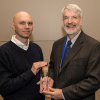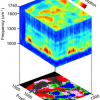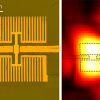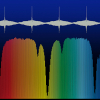Infrared Spectroscopy News
Enhancements of photoacoustic spectroscopy enable analysis of single melanoma cells and improved detection of melanoma.
The WADI project is using hyperspectral, multispectral and thermographic infrared imaging to detect soil moisture and those leaks from water mains in rural areas.
The 2017 Tomas Hirschfeld Award has been made to Satoru Tsuchikawa of Nagoya University, Japan.
Infrared spectroscopy images provide new insight into the development of plaques in early-stage Alzheimer’s disease.
University of Sydney researchers have used infrared spectroscopy to spotlight changes in tiny cell fragments called microvesicles to probe their role in a model of the body’s immunological response to bacterial infection.
Researchers at Lancaster University have used infrared spectroscopy to detect subtle early warning signs that reveal a frog population is at risk from pollution.
Given the increase in food-related health problems, the challenge set for the EU Horizon’s Food Scanner prize of €1 million was to develop an affordable and non-invasive mobile solution that enables users to measure and analyse their food intake.
On 15 March Ghent University officially launches a prestigious research project on precision agriculture, led by Abdul Mouazen.
Analytik have been appointed as exclusive distributors for the NeoSpectra range of low-cost, miniaturised, OEM FT-NIR spectral sensors.
Researchers have reported a new development of hyperspectral infrared nanoimaging. It is based on Fourier transform infrared nanospectroscopy (nano-FT-IR) and enables highly sensitive spectroscopic imaging of chemical composition with nanoscale spatial resolution.
Researcher from the Graphene Flagship have developed a novel graphene-based infrared (IR) detector demonstrating record high sensitivity for thermal detection. Graphene’s unique attributes pave the way for high-performance IR imaging and spectroscopy.
The International Council for Near Infrared Spectroscopy (ICNIRS) are pleased to invite nominations for the 2017 Tomas Hirschfeld Award.
Diffuse optical spectroscopic imaging (DOSI) using near infrared radiation can determine fat metabolism and has the potential to help determine if a diet and exercise regime is working.
Using fNIRS to track the brain activity of both participants, when people are asked to cooperate with a partner, found that males and females had different patterns of shared brain activity.
New broad-band tuneable infrared laser is single-chip, solid-state and offers high-power rapid tuning.
FT-IR spectroscopy can greatly increase the amount of information that can be extracted from a protein microarray. High-quality spectra can be obtained from spots of protein no larger than the diameter of a human hair.
Entries for the IRDG Chalmers and Dent Student Travel Award for a PhD to present their research at the SciX meeting.
Electro-optic modulators, which can switch light on and off within just picoseconds, are enabling ever faster telecommunication over fibre optics, and the same tools have now been harnessed for high-speed and accurate molecular sensing in the near infrared.
ChromaDex and American Laboratories have announced the release of a Fourier transform near infrared (FT-NIR) spectroscopy based identification method for the positive identification of desiccated bovine and porcine glandular tissues used in nutritional product formulations.









